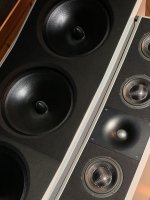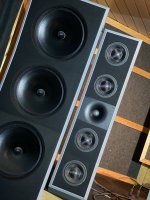Can you please elaborate? Obviously we are not talking abt removing protective grill.
Would think similarly to Troels project using Seas 35mm dome in Jantzen waveguide should work similarly well?
Obviously, I was wrong. Ergo succeeded (big time).
Any experience with BlieSMa T34B-4 Beryllium version of the tweeter? Comparisons to Satori, Scanspeak Be tweeters?
Test Bench: A New Beryllium Tweeter from BlieSMa | audioXpress
Test Bench: A New Beryllium Tweeter from BlieSMa | audioXpress
Are satisfied and the hunt for tweens is over
Nice, is that td15m?
Yes, it is
Bet it sounds awesome!
Do you have any documentation of your build?
This is a serious dome.
I come from a prosound background so I'm used to high output compression drivers that would leave many direct radiating domes fried in a matter of seconds. For my latest project, a prosound based live instrument monitor, I was set on a compression driver mounted directly on the baffle for extra wide dispersion. When I saw the review of the T34 I knew I had give it a try.
I recently received a Faital Pro HF146R. A 1.4" exit driver with a 2.5" dome. This model was specifically designed to sound less harsh at high levels. Initial tests were positive with a LR24 highpass at 2khz. Still got that bright icepick sound at high volumes but not as bad as other drivers I've heard.
The T34 was substituted, level matched, and eq'd to the same level as the HF146R. The Faital is about 9db's more senitive with impedance taken into account. To my surprise the Bliesma is able to achieve a subjectively cleaner sound at levels that would have me reaching for the volume control with most compression drivers.
How loud are we talking? With my live bright tone bass guitar (Marcus Miller to Les Claypool) I was clipping a 4 ohm 10PR300 with one channel of a PLD4.5 (2000w peaks) bandpassed between 330-2khz. Hard to hear yourself yell.
The top octave is obviously cleaner and more extended than the HF146R. I haven't had the pleasure of a hearing a Beryllium domed compression driver. The T34 should hold up very well in any domestic setting with its massive output capabilities and clean performance.
Test area shown below. Yes...the setup is far from optimized but that's part of the fun! Building is 60x40x16 feet. An 18 Sound 10NDA610 is on the way to join the party. Should make for a potent 3-way box with a pair of BMS 15N850's.
Hi,
Do you mean the faital was listened on the same plan bafle than the Bilesma, i.e. without horn in your benchmark ?
Wonderful tweeter. Reminds me of the power and body of compression drivers with beryllium diaphragm.
I did a test in Dali 104 and it sounds off coarse better than the original.
The tweeter isnt easy to work with regarding the crossover.
I am open for ideas for a hi eff florstander?

I did a test in Dali 104 and it sounds off coarse better than the original.
The tweeter isnt easy to work with regarding the crossover.
I am open for ideas for a hi eff florstander?
Last edited:
I've been now listening my T34B-4 matched pair for a few weeks. I have crossed them at 2900 hz, they would do much lower of course, but I have no need to go lower.
They are clearly the best tweeters I ever had, by far and I think for the performance, these are cheap!
If some day the diamond version comes out, I will get them right away.
They are clearly the best tweeters I ever had, by far and I think for the performance, these are cheap!
If some day the diamond version comes out, I will get them right away.
How deep is it realistic to high pass T34a/b?
Suesskind does it at 1250 Hz passive and i think Joachim Gerhard knows what he is doing:
https://suesskindaudio.de/en/ara
Troels Gravesen made a passive impedance correction (RCL) at fs for lower crossover:
http://www.troelsgravesen.dk/BlieSMa_T34A-4.htm
With active crossover, will a passive RCL have do any good?
I have Seas CA22RNY which is a high eff 8 inch midwoofer with large magnet, coated paper, smooth breakup and very good transients. Here it could be exiting to test first order passive crossover to get a easy load with less phase shifts:
https://www.diyaudio.com/community/...ay-with-8-inch-midbass-mini-waveguide.381537/
http://www.seas.no/index.php?option...le&id=95:h1471-08-ca22rny&catid=44&Itemid=461
Is a first order passive crossover around 1500 Hz, with impedance correction and paralell shelf or notch filter on Bliesma T34a/b a dead end consept?
Suesskind does it at 1250 Hz passive and i think Joachim Gerhard knows what he is doing:
https://suesskindaudio.de/en/ara
Troels Gravesen made a passive impedance correction (RCL) at fs for lower crossover:
http://www.troelsgravesen.dk/BlieSMa_T34A-4.htm
With active crossover, will a passive RCL have do any good?
I have Seas CA22RNY which is a high eff 8 inch midwoofer with large magnet, coated paper, smooth breakup and very good transients. Here it could be exiting to test first order passive crossover to get a easy load with less phase shifts:
https://www.diyaudio.com/community/...ay-with-8-inch-midbass-mini-waveguide.381537/
http://www.seas.no/index.php?option...le&id=95:h1471-08-ca22rny&catid=44&Itemid=461
Is a first order passive crossover around 1500 Hz, with impedance correction and paralell shelf or notch filter on Bliesma T34a/b a dead end consept?
Superlian,
I love my pair of T34B (in a waveguide by the way) but I would never use it with an electrical first order crossover at 1500 Hz.
First you forgot to consider the natural cutoff of the driver and even with first order, you will end up with a much steeper slope
Second, you will have to think about distortion and intended max SPL
third, you will have to consider horizontal et vertical polar map
You always have to think about those things as this can help a lot:Is a first order passive crossover around 1500 Hz, with impedance correction and paralell shelf or notch filter on Bliesma T34a/b a dead end consept?
- surface of emitting area (34 mm diameter)
- fs of device (about 850-900 Hz)
I love my pair of T34B (in a waveguide by the way) but I would never use it with an electrical first order crossover at 1500 Hz.
First you forgot to consider the natural cutoff of the driver and even with first order, you will end up with a much steeper slope
Second, you will have to think about distortion and intended max SPL
third, you will have to consider horizontal et vertical polar map
- Home
- Loudspeakers
- Multi-Way
- Bliesma T34 Tweeter

